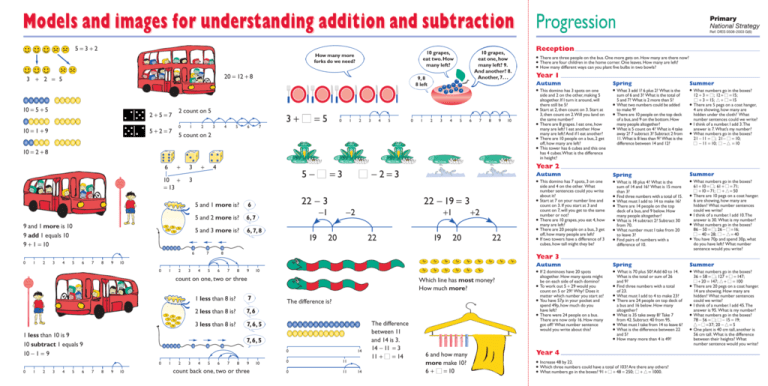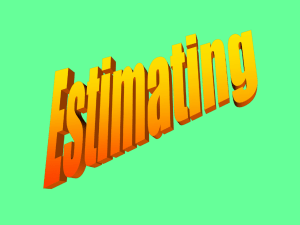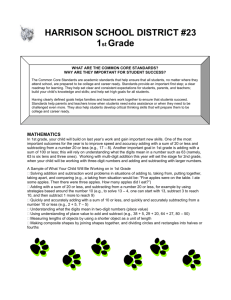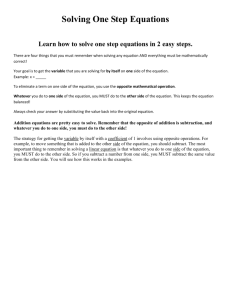Understanding addition and subtraction
advertisement

Models and images for understanding addition and subtraction Progression 5=3+2 How many more forks do we need? 20 = 12 + 8 3 + 2 = 5 10 = 5 + 5 2+5=7 10 = 1 + 9 5+2=7 9, 8 8 left 2 count on 5 0 1 2 3 4 5 10 grapes, eat one, how many left? 9. And another? 8. Another, 7. . . 10 grapes, eat two. How many left? 6 7 0 1 2 3 4 5 0 1 2 3 4 5 6 7 8 9 5 count on 2 + 3 10 + = 13 3 9 and 1 more is 10 9 add 1 equals 10 9 + 1 = 10 + 3 4 5 4 5−■ =3 22 − 3 5 and 1 more is? 6 5 and 2 more is? 6, 7 5 and 3 more is? −1 6 7 8 9 7 ■ −2=3 22 − 19 = 3 −2 +1 20 22 Autumn Spring Summer ● ● ● ● 1 2 3 4 5 6 7 8 9 4 5 6 7 8 9 10 2 3 19 20 22 Which line has most money? How much more? 1 less than 8 is? 7 2 less than 8 is? 7, 6 3 less than 8 is? 7, 6, 5 4 5 6 ● ● ● What 3 add 1? 6 plus 2? What is the sum of 6 and 3? What is the total of 5 and 7? What is 2 more than 5? What two numbers could be added to make 9? There are 10 people on the top deck of a bus, and 9 on the bottom. How many people altogether? What is 5 count on 4? What is 4 take away 2? 7 subtract 3? Subtract 2 from 11. What is 8 less than 9? What is the difference between 14 and 12? ● ● ● What numbers go in the boxes? 12 + 3 = ■ ; 12 + ■ = 15; ■ + 3 = 15; ▲ + ■ = 15 There are 5 pegs on a coat hanger, 4 are showing, how many are hidden under the cloth? What number sentences could we write? I think of a number. I add 3.The answer is 7. What’s my number? What numbers go in the boxes? 21 − 11 = ■ ; 21− ■ = 10; ■ − 11 = 10; ■ − ▲ = 10 Autumn Spring Summer ● ● ● ● 10 ● This domino has 7 spots, 3 on one side and 4 on the other. What number sentences could you write about it? Start at 7 on your number line and count on 3. If you start at 3 and count on 7, will you get to the same number or not? There are 10 grapes, you eat 4, how many are left? There are 20 people on a bus, 3 get off, how many people are left? If two towers have a difference of 3 cubes, how tall might they be? ● ● ● ● ● ● What is 18 plus 4? What is the sum of 14 and 16? What is 15 more than 3? Find three numbers with a total of 15. What must I add to 14 to make 16? There are 14 people on the top deck of a bus, and 9 below. How many people altogether? What is 14 subtract 2? Subtract 30 from 70. What number must I take from 20 to leave 3? Find pairs of numbers with a difference of 10. ● ● ● ● What numbers go in the boxes? 61 + 10 = ■ ; 61 + ■ = 71; ■ +10 = 71; ■ + ▲ = 50 There are 10 pegs on a coat hanger. 6 are showing, how many are hidden? What number sentences could we write? I think of a number. I add 10.The answer is 30. What is my number? What numbers go in the boxes? 86 − 50 = ■ ; 26 − ■ =16; ■ − 40 = 28; ■ − ▲ = 40 You have 70p and spend 30p, what do you have left? What number sentence would you write? 7 8 9 The difference is? count back one, two or three 10 Autumn Spring Summer ● ● ● ● ● ● 0 1 This domino has 3 spots on one side and 2 on the other, making 5 altogether. If I turn it around, will there still be 5? Start at 2, then count on 3. Start at 3, then count on 2.Will you land on the same number? There are 8 grapes. I eat one, how many are left? I eat another. How many are left? And if I eat another? There are 10 people on a bus, 2 get off, how many are left? This tower has 6 cubes and this one has 4 cubes.What is the difference in height? Year 3 7, 6, 5 0 3 +2 8 1 less than 10 is 9 10 subtract 1 equals 9 10 − 1 = 9 2 Year 1 ● 6, 7, 8 count on one, two or three 1 10 There are three people on the bus. One more gets on. How many are there now? There are four children in the home corner. One leaves. How many are left? How many different ways can you plant five bulbs in two bowls? Year 2 10 0 0 ● ● 19 6 2 ● ● 6 1 ● ● 10 = 2 + 8 0 Reception ● 3+■ =5 Ref: DfES 0508-2003 G(6) 0 0 14 11 11 14 The difference between 11 and 14 is 3. 14 − 11 = 3 11 + ■ = 14 If 2 dominoes have 20 spots altogether. How many spots might be on each side of each domino? To work out 5 + 29 would you count on 5 or 29? Why? Does it matter which number you start at? You have 57p in your pocket and spend 49p, how much do you have left? There were 24 people on a bus. There are now only 16. How many got off? What number sentence would you write about this? ● ● ● ● ● ● ● 6 and how many more make 10? 6 + ■ = 10 What is 70 plus 50? Add 60 to 14. What is the total or sum of 26 and 9? Find three numbers with a total of 23. What must I add to 4 to make 23? There are 24 people on top deck of a bus and 16 below. How many altogether? What is 35 take away 8? Take 7 from 42. Subtract 40 from 95. What must I take from 14 to leave 6? What is the difference between 22 and 5? How many more than 4 is 49? Year 4 ● ● ● Increase 48 by 22. Which three numbers could have a total of 103? Are there any others? What numbers go in the boxes? 91 + ■ + 48 = 250; ■ + ▲ = 1000. ● ● ● ● What numbers go in the boxes? 36 + 58 = ■ ; 127 + ■ = 147; ■ + 20 = 147; ▲ + ■ = 100 There are 20 pegs on a coat hanger. 14 are showing. How many are hidden? What number sentences could we write? I think of a number. I add 45.The answer is 95. What is my number? What numbers go in the boxes? 78 − 56 = ■ ; ■ − 15 = 19; ▲ − ■ =37; 20 − ▲ = 5 One plant is 40 cm tall, another is 56 cm tall. What is the difference between their heights? What number sentence would you write? Understanding addition and subtraction Other useful models and images Examples of progression and application in Years 4 to 6 These examples are drawn from section 6 of the Framework for teaching mathematics from Reception to Year 6. Potential difficulties Year 4 Children may: ● count forwards from one, as they are used to doing so when counting objects but cannot count from any starting number; ● count forwards confidently but lose their place and lack fluency when counting backwards, particularly when crossing the tens boundaries; ● ● not identify the number of items in a small group (subitise) and so have to count them out, consequently losing track when subtracting a small number mentally; ● use the take-away model when subtracting, e.g. 22 − 3, counting back to 19, but continue to apply the model to calculations such as 24 − 17 rather than use the difference model and count up from 17; ● ● count on or back without reference to the tens landmarks or knowledge of number facts and place value, e.g. counting on in ones from 15 when working out 26 − 15 rather than bridging though 20; add and subtract by counting on or back but not recognise the inverse relationship between the operations and so not be able to derive the associated subtraction facts from addition facts or vice versa; ● count on or back in tens and ones but not combine these processes, for example when subtracting nine, subtract ten and then adjust by adding one; ● associate + with addition and − with subtraction and do calculations such as 4 + 3 and 6 – 4, but not be able to find missing numbers in statements such as ■ + 4 = 9 and ■ – 4 = 5; ● ● 25 + 17 + 18 = 25 + (17 + 18) = 25 + 35 = 60 know the answer to one more or one less, but when adding or subtracting larger numbers make mistakes as they include the first number when counting on/back, e.g. say ‘16, 15, 14’ when subtracting 3 from 16; continue to rely on a combining model when adding two or more groups, having to count every object in the combined group rather than counting on from the larger group; recognise what calculation to do when word problems include the words add or take away, but are less confident when other language is used such as fewer, sum, total or difference; when shown, use resources or models such as number lines to help with simple calculations, but not be able to apply these to unfamiliar contexts or to solving simple word problems. Understand and use when appropriate the principles (but not the names) of the commutative and associative laws as they apply to addition. ● 86 + 95 = 95 + 86 ● U N D E R S TA N D I N G A D D I T I O N A N D S U B T R AC T I O N ● ● ● Understand that subtraction is non-commutative, i.e. 5 – 7 is not the same as 7 – 5. Understand that the sum of two positive numbers is greater than either number, and that subtracting a positive number makes a number less. Understand that addition is the inverse of subtraction (addition reverses subtraction and vice versa) and use this to check results. Check 625 − 87 = 538 with 538 + 87 = 625. ● Respond rapidly to oral or written questions, explaining the strategy used. 654 add 50; 63 subtract 46. Add 15, 6, 4, 15 and 1. What is the sum of 26 and 39? What is the difference between 28 and 65? Increase 48 by 22. What is 170 less than 250? Find three numbers with a total of 103. Find pairs of numbers with a difference of 79. Use known number facts to rapidly answer: 27 + 8 = ■ ; ■ + 12 = 19; 27 − 19 = ■ ; 43 − ■ = 4 Use a number line or mental strategies to answer: 76 + 58; ■ + ▲ + ● = 100; 136 − 78 = ■ ; ▲ − ■ = 54 Use jottings or a pencil and paper method to answer: 4136 + 3258 = ■ ; 1258 − 576 = ■ ; ▲ + ■ = 1000 ■ − ▲ = 682 Year 5 ● Respond rapidly to oral or written questions, explaining the strategy used. 3754 add 30; subtract 50 from 225 What is the sum of 16, 64 and 153? What is the difference between 155 and 390? Increase 190 by 37. How many more than 952 is 1050? 570 add a number is 620. What is the number? Use known facts to answer: Use a written method to answer: ■ + 62 = 189; 7.6 + 5.8 = ■ ; ■ − 62 = 189; 7.6 − 5.8 = ■ 14 136 + 3258 + 487 = ■ ; 141.36 − 32.58 Use informal pencil and paper jottings to answer: Use a calculator to: ■ + 756 = 924; ▲ + ■ = 1; ■ − 256 = 424; ■ − ▲ = 1.2 find all the different totals you can make by using three of these five numbers: 8, 4008, 562, 3103, 95 Find all the differences you can make by using two of the numbers. Year 6 ● Respond rapidly to oral or written questions, explaining the strategy used. Add 1200, 400, 600, 1200 and 15. Take 300 from 1240. Increase 250 by 420. How much less than 4.8 is 4.2? 2.8 add a number is 4.3. What is the number? Which three numbers could have a total of 1? Find pairs of numbers with a difference of 13.5. Use known facts to answer: Use a calculator to: ■ + 2.56 = 5.38; 91 + ■ + 48 = 250; ■ − 2.56 = 5.38; 7.65 − 6.85 = ■ find all the different totals you can make by using three of these five numbers: Use informal pencil and paper jottings to answer: ■ + 1475 = 6924; ■ + ▲ = 0.1; ■ − 1475 = 2924; ■ − ▲ = 0.03 1.07, 0.3, 37.03, 17.73, 31.7 Find all the differences you can by using two of the numbers. Use a written method to answer: 421.36 + 25.7 + 53.25 = ■ ; 421.3 − 82.57 = ■ See also section 6: mental calculation strategies (pages 40–47); pencil and paper procedures (pages 48–51); check results of calculations (pages 72–73); problems involving numbers in ‘real life’; money, time and measures (pages 82–89).






